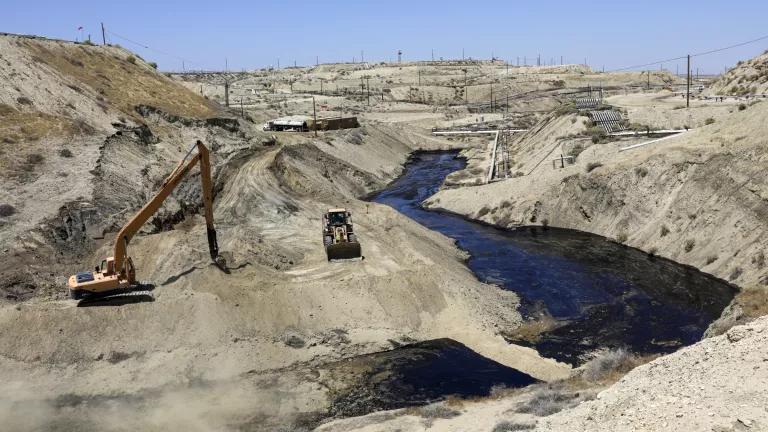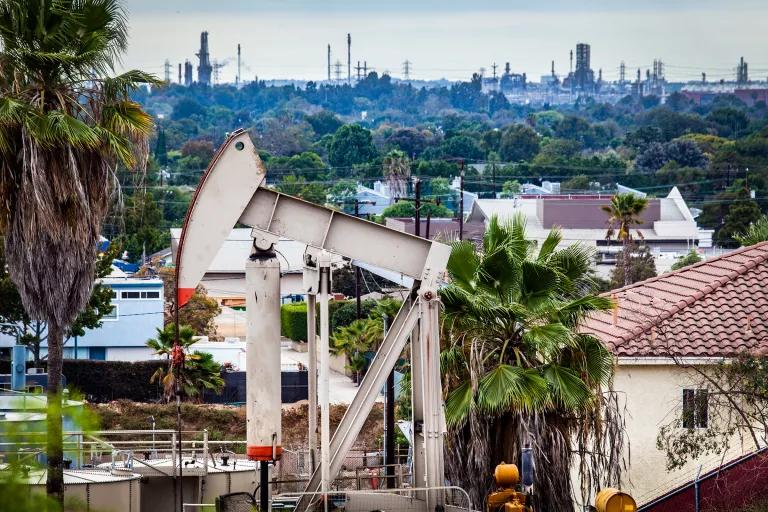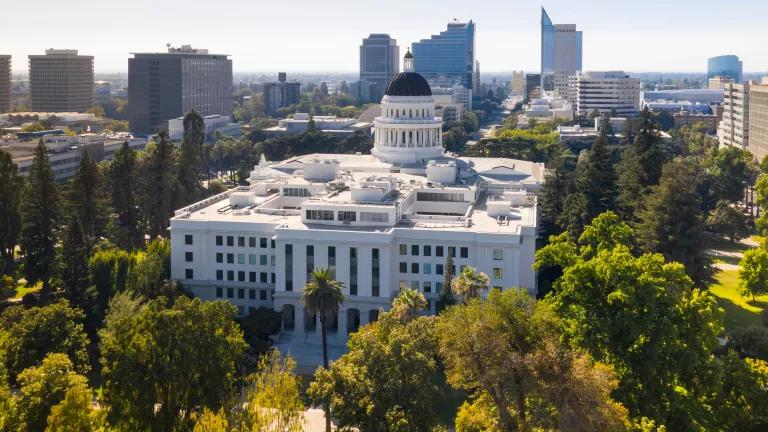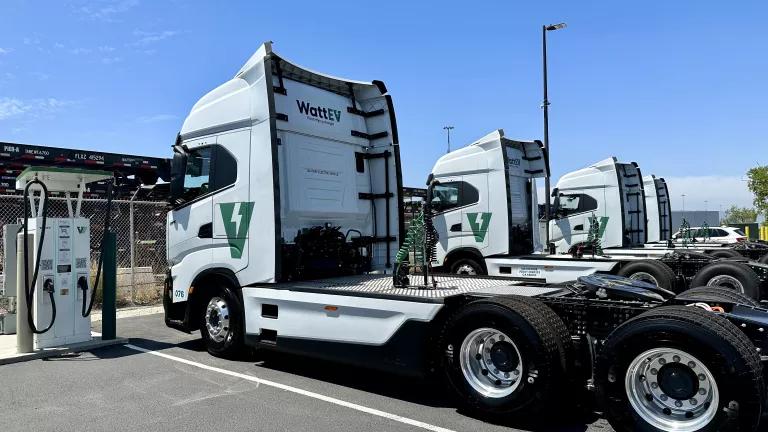Taking the Gloves Off in California Battle Over Oil
Armed with millions of dollars to pay lobbyists and a well-oiled astroturf machine to create the illusion of public support, the state's oil industry has successfully leaned on the state’s legislators to stay away from any meaningful reform efforts.

Crew works on seepage of 800,000 gallons of oil and brine water oil from an abandoned well Wednesday, July 24, 2019, in Chevron Corp's Cymric Oil Field in McKittrick, California (Irfan Khan/Los Angeles Times via AP, Pool)
California’s oil industry has an 800-pound gorilla reputation of getting pretty much what it wants in Sacramento. Armed with millions of dollars to pay lobbyists and a well-oiled astroturf machine to create the illusion of public support, it has successfully leaned on the state’s legislators—despite the Democratic supermajority in both houses—to stay away from any meaningful reform efforts.
But five California legislators are not having it. In no evident mood for pussyfooting around, Senators Wiener and Limon, joined by Senator Allen and Assembly Members Stone and Kalra as co-authors, have introduced SB 467, a bill that takes the gloves off in the fight to protect the public against the unusually dirty and risky oil extraction practices that are prevalent in our state.
The bill will have three distinct components. The first is a response to Governor Newsom’s call in an executive order last September for a ban on fracking in the state. SB 467 bans new and renewed fracking permits as of 2022, but goes beyond what the Governor called for by also banning other methods of enhanced oil recovery currently in use in California, including steam flooding, water flooding and cyclic steaming. The second component of the bill, not yet in the published text but soon to be amended into it, mandates that all oil drilling operations be set back a minimum of 2,500 feet from homes, schools, and health care facilities. And the third component is an effort to address the employment consequences of a transition away from fossil fuel production.
The enhanced oil recovery ban
By expanding on the Governor’s mandate to ban fracking, Senators Wiener and Limon are recognizing that fracking—while highly problematic as a production method—is not the biggest threat to California communities. Unlike Pennsylvania, North Dakota, Texas, and other oil producing states, where the boom in oil and gas production over the last two decades was driven by fracking, fracking is not particularly prevalent in California. Governor Newsom has stated that it represents less than 2 percent of our overall oil production.
The enhanced oil recovery methods that SB 467 would ban, however, are far more widespread in California, and are wreaking well-known environmental havoc. Cyclic steaming is the most visible offender. Designed to melt out of the ground the tarry, viscous oil that’s left after a century of production of the easier-to-get more liquid oil, cyclic steaming involves heating up large amounts of steam and pumping it into the ground. Not only is this process absurdly greenhouse gas-intensive, since the steam is generally heated up using fossil fuels, but it regularly causes oil spills, particularly when used in a manner that fractures the rock formation containing the oil. A couple of years ago, Chevron caused a major spill in the Cymric oil field in Kern County using this method, but such spills are nothing new—uncontrolled releases have been happening in that field since 2003.
The Geologic Energy Management Division (CalGEM), which oversees oil drilling in California, finally began to regulate cyclic steaming in April 2019. Only months later, after CalGEM took stock of the spills the practice was causing, Governor Newsom issued a moratorium on the high-pressure variant that breaks up rock formations. That moratorium remains in effect while CalGEM is studying cyclic steaming. But the Wiener and Limon bill takes the bolder approach, based on the pretty abundant evidence of harm we have right now, of simply calling a permanent halt to the practice.
What we don’t know—and would know, if we had a more robust and transparent oil well permitting system in place—is what percentage of California’s production is represented by the non-fracking oil recovery methods that are swept into the SB 467 proposed ban. Informal estimates are that cyclic steaming (high- and low-pressure combined) accounts for roughly 21 percent of California’s oil production—that is, more than 10 times what the Governor has said fracking accounts for.
Beyond that, we simply do not have a solid estimate for the percentage of the state’s production represented by steam flooding and water flooding. The reason is that information regarding production methods is not routinely collected by CalGEM when issuing authorization to drill. The required process for obtaining such authorization is rather limited, when one considers the environmental risks involved. Someone who wants to drill an oil well need only provide a “notice of intention” to do so on a short form; and CalGEM does not review the environmental impact of the proposed well under the California Environmental Quality Act.
The Western States Petroleum Association asserts, in its opposition to SB 467, that it would “lead to a total production ban in California.” This hyperbolic statement is devoid of citation however, because data to support it doesn’t exist in any reliable public form. A key takeaway from the discussion around SB 467 should be that it is critical for our state to develop and publicize basic information about how our oil is being produced.
It is also unclear whether Governor Newsom will support SB 467 when the political rubber hits the road. His support will be critical given the forces allied against it. The Governor did recently affirm, as reported behind a paywall by California PoliticoPro, that he continues to support a legislative fracking ban. But he has not yet said whether he will support the broader enhanced oil recovery ban proposed in the bill. Right after he called for a fracking ban last September, he referred to such a ban as being merely “symbolic.” Time will tell whether he will support the decidedly less symbolic production ban embodied in SB 467.
The setback requirement
The drilling setback component of SB 467, to be amended into the text soon, is not a new proposal. In fact, it’s long overdue. The need for setbacks has been a subject of vigorous advocacy for years from communities and their allies who point out that most other oil and gas producing states have such setbacks in place, but California—for all its reputation for progressive regulation—does not.

Oil pumpjack in a residential area next to homes with oil refineries in the background near the port of LA and port of Long Beach. Signal Hill, California. (Gary Kavanagh/iStock)
Last year, advocates expended extensive effort in support of AB 345, which would have required that CalGEM establish a setback, and in doing so consider whether 2,500 feet is the right distance. The idea was to provide bounds around CalGEM’s consideration of the need for setbacks in the context of its ongoing public health rulemaking, which was initiated in the same gubernatorial announcement that put a moratorium on high-pressure cyclic steaming. AB 345, sponsored by Assembly Member Muratsuchi, died in committee, following heated—and misguided—diatribes about how CalGEM’s ongoing rulemaking efforts should be left untouched (there is, in fact, nothing out of the ordinary about legislation that places substantive bounds around agency rulemaking).
An early look at the anticipated SB 467 setback provisions indicates they will take a tougher line than did AB 345. While AB 345 did not specify outright the required magnitude of the setback, it appears SB 467 will plainly state that the setback must be 2,500 feet. If CalGEM does not establish a setback of that magnitude in its rulemaking by July 2022, then SB 467 would kick in to require it. Since CalGEM is expected to issue a discussion draft of its proposed regulations this spring, which will address setbacks in some fashion that may or may not reflect the 2,500 feet, the practical import of the SB 467 setback approach will soon be clearer.
While that chain of events unfolds, what’s clear right now is that a setback rule is necessary, and it’s a crime that California does not have one yet. Millions of Californians live in proximity to oil and gas wells—the large majority of them being vulnerable communities of color. In the last decade, a veritable pile of studies has accumulated that show significantly elevated health risk in proximity to drilling operations. We’ve gone from knowing not much about the human health impacts of wells back in the aughts, when US production volumes were ramping up, to now having more than two dozen peer-reviewed studies showing, again and again, that living near oil wells risks some potentially serious health consequences.
A summary of peer-reviewed studies by the non-profit research institute PSE Healthy Energy documents these risks. They include, among others, risk of poor pregnancy outcomes (birth defects, preterm birth, and fetal death), cancer, respiratory and cardiovascular problems, asthma exacerbation, and health problems associated with constant loud noise. In many cases, the risk was associated with air pollution from drilling operations, particularly petroleum-related air toxics like benzene, toluene, and xylene.
Some California communities, along with most oil and gas producing states, have setbacks in place of several hundred feet (with the notable exception of Ventura County, which recently put in place a 2,500 foot setback). But these small setbacks are not sufficient. The published literature points to the need for the 2,500 foot distance that would be mandated by SB 467. The California Council on Science and Technology’s (CCST) study of fracking health risks mandated by SB 4, California’s 2013 fracking law, found that “the most significant exposures to toxic air contaminants” occur within a half-mile of well operations, and recommended consideration of setbacks. The PSE Healthy Energy study and other compilations of the health literature reference findings of health risk even for people living a mile or more away from drilling operations; and even more frequently within a half-mile (2,640 feet).
So the procrastination on a robust statewide setback needs to end, one way (via a CalGEM rulemaking) or the other (via SB 467). The status quo is untenable.
Displaced worker provisions
SB 467 tasks CalGEM with identifying oil industry workers who have lost their jobs, and providing incentives to companies involved in remediating abandoned oil and gas well sites to hire those workers. This provision is a nod to widespread recognition that the decline in oil production in California—which is already happening, whether we give that decline a push or not—is going to require a concerted effort to ensure a “just transition” for workers and communities into other economic sectors.
What will be needed, in order to make SB 467’s efforts in this regard truly effective, is what’s usually needed to address major economic problems: an influx of cash. The incentives that SB 467 calls for are critical, and directing displaced workers to helping address California’s looming half-billion dollar abandoned well crisis is an excellent idea. But the incentives will need to be funded.
What’s next
The joining of the original SB 467 enhanced oil ban provisions with the resurrected and enhanced AB 345 setback provisions is going to change the conversation about oil in Sacramento, as community and clean energy forces clash head-on with defenders of the status quo. While the concepts reflected in SB 467 have been discussed in various forms and contexts over the years, their consolidation into an aggressively-framed, no-holds-barred bill will force legislators to confront the destructive impact of California’s oil industry on the communities who have to live with it. And to think about ways to transition away from it as we take steps to reduce our demand for oil and move toward a clean energy future.
That conversation was bound to come to the forefront sooner or later. Community and environmental advocates appreciate that, thanks to Senators Wiener and Limon and their co-authors, we’re going to go with sooner.




